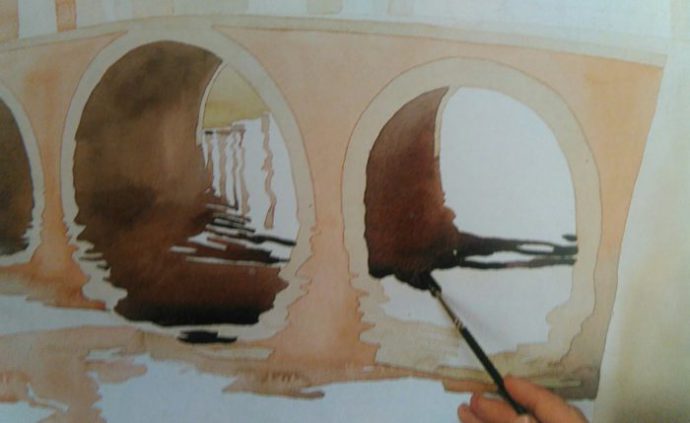Moving water is one of the most attractive parts of landscapes for painting but also one of the most difficult to capture because of its flickering changing nature. Waves move, reflections change from big to small and before you know it you have a bunch of different effects on your painting making it look confusing more than anything else if you try to capture them all.
The secret of painting water with
Try adding paint on wet paper and let it mix spontaneously to get the impression of a foggy lake. Small waves and reflections can be depicted with small doodle like moves here and there letting your brush strokes depict movements of the water.
Reflections
Remind yourself that the reflections abide by some laws of perspective that will make it easier for you to paint them. For example, the reflection of a light object is always slightly darker than the object itself and visa verse. The object that is standing straight in the water produces the reflection of the same length but the length of reflection of the object that is leaned towards you seems longer.
When the water surface is wavy the reflections scatter and look longer than the object. Those reflections also abide by the laws of perspective meaning they get smaller the farther they are.



Amsterdam Canal
To paint this you will need the following:
- One sheet of cold pressed
watercolor paper - Round brush number 10
- Round brush number 8
- Round brush number 3
- HB pencil
You will also need the following colors:
- Naples light yellow
- Ochre yellow
- Raw brown
- Brown-red alizarine
- Green
- Grey
Sketching
Slightly sketch the entire composition using an HB pencil. Use a thin solution of Naples yellow to colour the entire surface of the painting apart from a water surface with brush number 10. For water surface also use a thin solution of Cobalt blue. Leave the painting to dry.
Paint the stone bridge and its reflection in the water with the palest tones using a mixture of Ochre yellow and Raw brown. Use the same color for the stone wall in the right corner of the painting. Leave the painting to dry.
Prepare a slightly darker mixture of Raw brown and Ochre yellow and use it to colour stone details on top of the bridge with round brush number 8. Then paint the details along the arches and also paint their reflections in the water making wavey lines to depict the waves. Leave the painting to dry.
Mix brown-red alizarine with raw brown to get warm pinkish to paint the bricks on the bridge and their reflection in the water. Again use smooth wavey moves to depict the movement of the water. Using the mixture you previously used for the bridge and the arches paint some of the details of the trees and the buildings in the background that can be seen over the rim of the bridge railing.



Adding The Details
Using round brush number 3 paint grassy bank on the left side with a pale tone of dark green mixed with raw brown.For the reflections that are seen through the same arch use the mixture of dark green, raw brown and brown-red alizarine.
Dilute the
Mix darker version of the



Finishing Touches
Draw some lines with the pencil in order to point out the certain stone blocks around the arches. Build the shapes of the trees in the background using different tones of dark green and raw brown. Paint the dark areas inside the arches again using brown-red alizarine and grey but this time add a bit more grey.
Finish working on the reflections under the left side of the arches with brown-red alizarine and raw brown. With the mixture of same
Paint the dark waves in the blue water with cobalt blue a bit darker than you used for the first layer of paint. Use the brush in a manner to depict the reflections of the sky in the water. Mix dark brown-black using grey and raw brown and using the tip of the brush paint the thin shapes of the railing on the bridge. |delute the
Finish your painting by adding the reflections of the bicycles and the railing using the premade mixture but with a little bit of brown-red alizarine added. use the continuous curved lines to depict the movement of the water.
If you have any questions regarding the subject leave them below and I will be more than happy to answer.




0 Comments